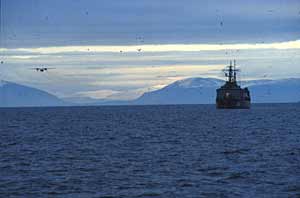
The system built to manage Russia’s nuclear legacy is crumbling, our new report shows
Our op-ed originally appeared in The Moscow Times. For more than three decades, Russia has been burdened with the remains of the Soviet ...
News

Publish date: February 8, 2000
Written by: Thomas Nilsen
News
Russia has carried out seven underground tests at the nuclear test field at Novaya Zemlya archipelago in the Russian Arctic, Itar-Tass reported. Radioactive discharges from the tests were reported earlier. Since September 1998, at least 14 subcritical tests were blasted in the tunnels near the Matotchin Shar that divides the northern and southern island of Novaya Zemlya.
Cited by Itar-Tass, Yury Bespalko, spokesman for the Russian Nuclear Energy Ministry (Minatom), said the aim of the tests was to determine the reliability of Russia’s nuclear weapon stockpile. On the other side, there is no secret that the Russian nuclear weapon designers also work on developing the next generation of nuclear devices. The test intensity at Novaya Zemlya during the past month has never been observed before.
The scientists that are preparing and conducting the tests and analysing the aftermath results come from the nuclear research centres in Snezinsk and Sarov. No information is available regarding Russia’s plans to conduct more subcritical tests at Novaya Zemlya.
Subcritical tests, or what Minatom calls them – hydrodynamical experiments, contain the ingredients of a nuclear warhead, plutonium or uranium, but fizzle out without any thermonuclear blast and, theoretically, are not accompanied by radioactive emissions. The test range is off-limits for civilian regulatory authorities, making it hard to obtain accurate information on possible radioactivity discharges and nature of ‘experiments’ conducted there. Last autumn, U.S. Secretary of Energy Bill Richardson requested his Russian counterpart Yevgeny Adamov to allow American specialists into the test site to make sure that only subcritical experiments were conducted.
The Comprehensive Test Ban Treaty (CTBT) does not prohibit subcritical tests – the fact that many of the signature countries to the treaty have criticised. This flaw in the CTBT allows countries like USA and Russia to continue research and development of new nuclear devises, making other countries nervous.

Our op-ed originally appeared in The Moscow Times. For more than three decades, Russia has been burdened with the remains of the Soviet ...

The United Nation’s COP30 global climate negotiations in Belém, Brazil ended this weekend with a watered-down resolution that failed to halt deforest...

For more than a week now — beginning September 23 — the Zaporizhzhia Nuclear Power Plant (ZNPP) has remained disconnected from Ukraine’s national pow...

Bellona has taken part in preparing the The World Nuclear Industry Status Report 2025 and will participate in the report’s global launch in Rome on September 22nd.